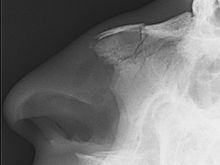Signs and symptoms of nasal fracture:
- Bruising, swelling, tenderness, pain, and deformity in the nose and nasal region of the face
- Bleeding from the nose (epistaxis)
- Difficulty breathing through the nose
- Excessive nosebleeds if the nasal mucosa are damaged
- Bruising around one or both eyes
Causes of nasal fracture:
- Physical trauma to the face
- Sports injuries
- Fighting
- Falls
- Car accidents
Diagnosis of nasal fracture:
- Visual identification and physical examination
- Questions about noticeable cosmetic deformity and difficulty breathing
- Medical imaging is generally not recommended
- Distinguishing simple fractures (Type 1) from fractures involving other facial bones and/or the nasal septum (Types 2 and 3)
- X-rays or CT scans may be required if other facial injuries are suspected
Treatment of nasal fracture:
- Minor nasal fractures may heal on their own without significant cosmetic deformity
- Ice and pain medication can be prescribed for discomfort during healing
- Manual alignment (closed reduction) may be attempted for deformed noses
- Manual alignment should be performed within 10 days of injury in adults and within 4 days in children
- Injuries involving other structures may require surgical treatment
Prognosis of nasal fracture:
- Bone stability occurs between 3 and 5 weeks after fracture
- Full bone fusion occurs between 4 and 8 weeks after fracture
A nasal fracture, commonly referred to as a broken nose, is a fracture of one of the bones of the nose. Symptoms may include bleeding, swelling, bruising, and an inability to breathe through the nose. They may be complicated by other facial fractures or a septal hematoma.
| Nasal fracture |
|---|
| Other names | Broken nose |
|---|
 |
| Plain X-ray showing a nasal fracture |
| Specialty | Emergency medicine, otorhinolaryngology |
|---|
| Symptoms | Nose bleed, swelling, bruising |
|---|
| Complications | Septal hematoma, other facial fractures, meningitis |
|---|
| Usual onset | Young males |
|---|
| Causes | Assault, trauma during sports, falls, motor vehicle collisions |
|---|
| Diagnostic method | Typically based on symptoms, occasionally plain X rays |
|---|
| Treatment | Pain medication, cold compresses, possible reduction post resolution of swelling |
|---|
| Prognosis | Generally good |
|---|
| Frequency | Common |
|---|
The most common causes include assault, trauma during sports, falls, and motor vehicle collisions. Diagnosis is typically based on the signs and symptoms and may occasionally be confirmed by plain X-ray.
Treatment is typically with pain medication and cold compresses. Reduction, if needed, can typically occur after the swelling has come down. Depending on the type of fracture reduction may be closed or open. Outcomes are generally good. Nasal fractures are common, comprising about 40% of facial fractures. Males in their 20s are most commonly affected.

